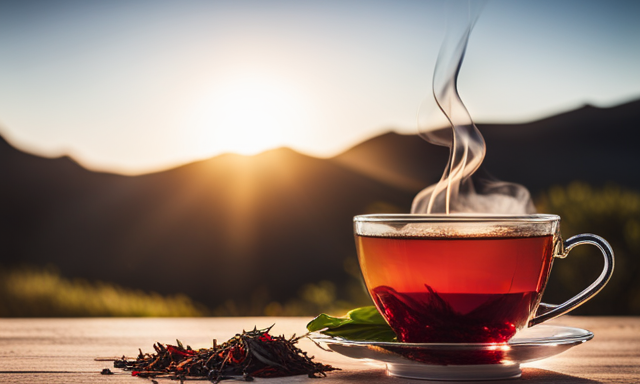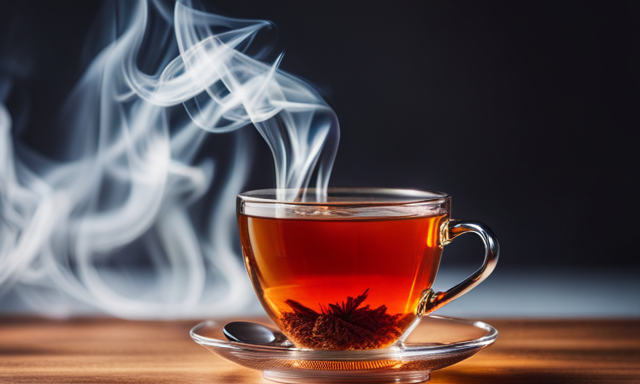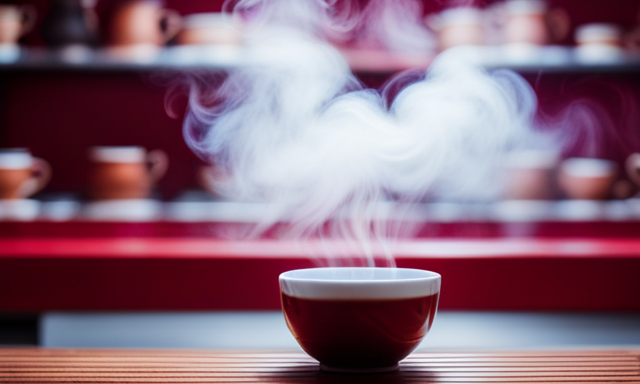As a tea enthusiast, I have always been captivated by the world of exotic and unique blends. One such blend that has caught my attention is rooibos. This vibrant and aromatic herbal tea, native to the rugged mountains of South Africa, has gained popularity for its numerous health benefits and delightful flavors.
In this article, I will take you on a journey to discover the secrets of rooibos and how it can be enjoyed. From its origins and cultivation methods to the various ways it can be prepared, we will explore the versatility of this caffeine-free alternative.
But rooibos is not just limited to a soothing cup of tea. It can also be infused into culinary delights and used as a beauty aid. So, grab a cup of steaming rooibos and join me in unraveling the wonders of this extraordinary drink.
Key Takeaways
- Rooibos is a caffeine-free herbal tea that offers numerous health benefits and delightful flavors.
- Rooibos can be enjoyed hot or cold and can be used as a base for lattes and cocktails.
- Rooibos is rich in antioxidants, which can help protect against chronic diseases and reduce oxidative stress and inflammation in the body.
- Rooibos promotes digestive health, soothes the digestive system, and supports the growth of beneficial gut bacteria.
Origins and Cultivation of Rooibos
Rooibos, a popular South African herbal tea, has a rich history and is cultivated with great care in the picturesque mountains of the Cederberg region. The origins of Rooibos farming techniques can be traced back centuries, when indigenous Khoisan tribes discovered the plant’s natural health benefits.
Today, Rooibos is grown using sustainable agricultural practices, ensuring the preservation of both the environment and the quality of the tea. The plants are nurtured in nutrient-rich soil and carefully tended to, allowing them to thrive in the unique climate of the region.
After harvesting, Rooibos goes through a meticulous processing method, where the leaves are fermented, dried, and carefully sorted. This process enhances the tea’s distinct flavor and aroma, resulting in a soothing and refreshing beverage.
Moving on to rooibos preparation methods, the next step involves…
Rooibos Preparation Methods
When it comes to preparing a cup of rooibos, there are a few key points to consider. Traditional brewing techniques, such as using a teapot or a French press, can enhance the flavor and aroma of the tea.
Infusion and steeping times are crucial in order to extract the full potential of the rooibos leaves.
Lastly, experimenting with different rooibos blends and flavor variations can add a unique twist to your cup, allowing you to discover your personal favorite.
Traditional Brewing Techniques
To experience the full flavor profile of rooibos, you should steep the leaves in boiling water for at least five minutes, allowing the intricate blend of earthy and sweet notes to fully develop. Traditional brewing techniques are still highly regarded for extracting the rich flavors of rooibos. Here are four key steps to follow when brewing rooibos using traditional methods:
-
Boil water: Bring fresh, filtered water to a rolling boil to ensure the leaves are steeped at the ideal temperature.
-
Measure the leaves: Use one teaspoon of loose rooibos leaves per cup of water for a robust flavor.
-
Steep the leaves: Place the leaves in a teapot or infuser and pour the boiling water over them. Let it steep for five to seven minutes for optimal flavor extraction.
-
Strain and enjoy: After steeping, strain the liquid into your cup and savor the vibrant taste of rooibos.
Now, let’s explore the importance of infusion and steeping times in the next section.
Infusion and Steeping Times
If you want to experience the full flavor of this delightful herbal tea, it’s all about finding the perfect infusion and steeping times.
Rooibos is a versatile drink that can be enjoyed hot or cold, and the infusion techniques play a crucial role in bringing out its unique taste.
To extract the rich flavors and aromas, it’s recommended to steep rooibos for about 5-7 minutes. This allows the leaves to fully release their essence into the water, resulting in a satisfying cup of tea.
Additionally, steeping temperatures should be around 200°F (93°C) to ensure the optimal extraction of flavors without any bitterness.
Once you’ve mastered the infusion and steeping times, you can explore the world of rooibos blends and flavor variations seamlessly, discovering new and exciting taste profiles.
Rooibos Blends and Flavor Variations
Delving into the world of rooibos blends and flavor variations opens up a realm of endless taste possibilities for tea enthusiasts. Rooibos, also known as red bush tea, is a versatile herbal tea that can be enjoyed on its own or blended with other ingredients to create unique flavors.
From fruity blends like peach and mango to spicy combinations like chai and cinnamon, there is a rooibos blend to suit every palate. The infusion methods for rooibos are also diverse, with options for hot brewing, cold brewing, and even using it as a base for lattes and cocktails.
These different blends and flavors not only provide a delightful sensory experience but also offer various rooibos tea benefits, such as being rich in antioxidants and promoting relaxation. Transitioning into the subsequent section about the health benefits of rooibos, it’s fascinating to explore how this flavorful tea can also be beneficial for our well-being.
Health Benefits of Rooibos
Rooibos, a popular herbal tea, offers various health benefits. Firstly, it’s known for its antioxidant properties, which can help protect the body against free radicals and reduce the risk of chronic diseases.
Additionally, rooibos has potential anti-inflammatory effects, which may help alleviate inflammation-related conditions such as arthritis.
Lastly, this tea promotes digestive health by soothing the digestive system and relieving symptoms like indigestion and stomach cramps.
Antioxidant Properties
Explore the truth behind the theory that drinking rooibos can boost your antioxidant intake. Rooibos tea has gained attention for its potential health benefits, particularly its antioxidant properties. Antioxidants are compounds that help protect the body against damage caused by free radicals, which are unstable molecules that can harm cells.
Research on rooibos tea suggests that it contains high levels of antioxidants, such as aspalathin and nothofagin, which may help reduce oxidative stress and inflammation in the body. However, it’s important to note that more research is needed to fully understand the extent of rooibos tea’s antioxidant benefits.
Additionally, while rooibos tea is generally considered safe to consume, it’s always a good idea to consult with a healthcare professional, especially if you have any underlying health conditions.
Transitioning into the next section, let’s now explore the potential anti-inflammatory effects of rooibos tea.
Potential Anti-inflammatory Effects
One intriguing aspect to consider is the potential anti-inflammatory effects that can be associated with consuming rooibos tea. Rooibos tea contains various compounds, such as aspalathin and nothofagin, which’ve been found to possess anti-inflammatory properties. These compounds may help reduce inflammation in the body by inhibiting the production of pro-inflammatory molecules and promoting the activity of anti-inflammatory enzymes.
Research suggests that the anti-inflammatory effects of rooibos tea may have potential therapeutic applications in the management of conditions such as arthritis, allergies, and skin disorders. The exact mechanisms of action behind these effects are still being studied, but the antioxidant properties of rooibos tea are believed to play a role.
In addition to its potential anti-inflammatory benefits, rooibos tea also promotes digestive health by soothing the digestive tract and supporting the growth of beneficial gut bacteria.
Promotes Digestive Health
Supporting digestive health, rooibos tea can help soothe your stomach and cultivate a flourishing gut microbiome. Here are three reasons why rooibos promotes gut health and aids digestion:
-
Soothing Properties: Rooibos tea contains anti-inflammatory compounds that can help reduce inflammation in the digestive system, soothing any discomfort and promoting a healthy gut environment.
-
Antioxidant Boost: Packed with antioxidants, rooibos tea can help protect the digestive system from free radicals, reducing the risk of digestive disorders and promoting overall digestive health.
-
Natural Digestive Aid: Rooibos tea contains enzymes that can aid in the breakdown of food, making it easier for the body to digest and absorb nutrients.
With its ability to support digestive health and aid in digestion, rooibos tea is a great caffeine-free alternative. Transitioning into the next section, let’s explore how rooibos can be a satisfying option for those looking to reduce their caffeine intake.
Rooibos as a Caffeine-Free Alternative
As someone who’s sensitive to caffeine, I’ve found rooibos to be a fantastic alternative. Not only does it provide a delicious and satisfying beverage option, but it also offers a range of health benefits.
Rooibos is known for its relaxing and soothing effects, making it the perfect choice for those looking to unwind after a long day. Whether enjoyed hot or cold, rooibos is a caffeine-free option that can be enjoyed by everyone.
Benefits for Individuals Sensitive to Caffeine
For individuals sensitive to caffeine, drinking rooibos can be a great alternative as it’s naturally caffeine-free. Studies show that over 40% of people experience negative effects from consuming caffeine. Caffeine sensitivity can cause symptoms like jitters, anxiety, and sleep disturbances, making it challenging for some individuals to enjoy their daily cup of coffee or tea.
Rooibos provides a delicious and satisfying option for those seeking a caffeine-free beverage. Not only does it offer a similar taste and aroma to traditional teas, but it also boasts numerous health benefits. Rooibos is rich in antioxidants, which can help reduce inflammation and support overall well-being. Additionally, it contains minerals like calcium, magnesium, and potassium, which are essential for maintaining healthy bodily functions.
So, if you’re looking for an alternative to coffee that won’t disrupt your sleep or cause unwanted side effects, rooibos is definitely worth a try. Its relaxing and soothing effects make it a perfect choice for winding down after a long day.
Relaxing and Soothing Effects
Looking for a way to unwind and feel at ease after a hectic day? Look no further than the relaxing and soothing effects of enjoying a cup of caffeine-free rooibos tea. Rooibos tea, also known as red bush tea, has been cherished for centuries in South Africa for its numerous health benefits. This herbal infusion is not only delicious but also offers a range of benefits, making it the perfect drink for those seeking relaxation and tranquility.
One of the key benefits of rooibos tea is its ability to promote a sense of calmness and relaxation. The tea contains natural compounds that have been found to have a soothing effect on the nervous system, helping to reduce stress and anxiety. This makes it an excellent choice for individuals looking to unwind and find inner peace through meditation.
Additionally, rooibos tea is often used as a sleep aid due to its calming properties. The tea contains antioxidants that help to regulate the sleep cycle and promote a more restful night’s sleep. By enjoying a cup of rooibos tea before bed, you can enhance your sleep quality and wake up feeling refreshed and rejuvenated.
| Benefit | Description |
|---|---|
| Meditation benefits | Rooibos tea’s calming effect on the nervous system makes it an ideal companion for meditation practices. |
| Sleep aid | The soothing properties of rooibos tea help regulate the sleep cycle, promoting a more restful night’s sleep. |
| Antioxidants | Rooibos tea is rich in antioxidants, which have numerous health benefits and contribute to overall well-being. |
As you can see, rooibos tea offers a range of benefits that can support your well-being and help you find relaxation and tranquility. In the next section, we will explore how rooibos can add a delightful touch to culinary creations, giving you even more reasons to incorporate this wonderful tea into your daily routine.
Rooibos in Culinary Delights
Rooibos is absolutely perfect for adding a unique and delightful twist to all of your favorite culinary creations. It’s versatile flavor profile makes it a great ingredient in both sweet and savory dishes.
When used in desserts, rooibos adds a subtle, earthy sweetness that pairs well with chocolate, vanilla, and citrus flavors. It can be infused into creams, custards, and syrups to give your desserts an extra depth of flavor.
In savory dishes, rooibos can be used to infuse broths, marinades, and sauces, adding a hint of warmth and complexity. Some popular culinary uses for rooibos include rooibos-infused cocktails, rooibos-glazed meats, and rooibos-infused vinaigrettes.
With its rich and aromatic qualities, rooibos is truly a versatile ingredient in the kitchen. It can take your recipes to a whole new level of deliciousness.
Now let’s explore how rooibos can also be used as a beauty aid.
Rooibos as a Beauty Aid
As a beauty aid, rooibos has numerous benefits for skincare, hair care, and scalp health. When used in skincare products, rooibos can help soothe and calm irritated skin, thanks to its anti-inflammatory properties. It’s also rich in antioxidants, which can help fight free radicals and reduce the signs of aging. Additionally, rooibos can be used as a rinse for hair to promote healthy scalp and hair growth. It can help balance pH levels and nourish the hair follicles.
Benefits for Skincare
One of the most alluring benefits of incorporating rooibos into your skincare routine is the natural glow it gives your complexion. Rooibos isn’t just a delicious tea, but it also offers incredible benefits for your skin.
When it comes to acne treatment, rooibos is a game changer. Its anti-inflammatory properties help soothe irritated skin and reduce redness. Additionally, rooibos is packed with antioxidants that fight against free radicals, slowing down the aging process. This means that incorporating rooibos into your skincare routine can help reduce the appearance of fine lines and wrinkles, giving you a more youthful complexion.
Now, let’s move on to another amazing aspect of rooibos: its benefits for hair care and scalp health.
Hair Care and Scalp Health
To unlock the secret to luscious locks and a healthy scalp, let the magic of rooibos infuse your hair care routine, turning it into a soothing oasis for your precious strands. Rooibos isn’t just a delightful beverage; it also offers remarkable benefits for hair growth and scalp conditions.
Rich in antioxidants, rooibos promotes hair growth by improving blood circulation to the scalp, which stimulates hair follicles. It also helps balance sebum production, preventing dryness or excessive oiliness that can lead to scalp conditions like dandruff or itchiness.
Additionally, rooibos is packed with minerals like zinc and calcium, nourishing and strengthening hair from root to tip. So, whether you’re struggling with hair loss or simply want to maintain a healthy scalp, incorporating rooibos into your hair care routine is a wise choice.
Now, let’s explore the different rooibos varieties and flavors.
Rooibos Varieties and Flavors
When it comes to rooibos, there are three main varieties and flavors that are worth exploring.
Traditional Red Rooibos is the classic and most widely known type, with its rich, earthy taste and vibrant red color.
Green Rooibos, on the other hand, offers a unique twist with its lighter flavor and grassy undertones.
Lastly, there are also flavored rooibos blends that combine the natural goodness of rooibos with various fruits, herbs, and spices, adding a delightful burst of flavor to your cup.
Traditional Red Rooibos
Discover the delightful taste of traditional red rooibos, a soothing and caffeine-free beverage. Originating from the Cederberg region of South Africa, this ancient herbal tea has been enjoyed for centuries.
The rooibos plant, scientifically known as Aspalathus linearis, is cultivated in the rugged mountains and harvested by hand. The leaves and stems are then finely chopped, oxidized, and dried in the sun, giving the tea its vibrant red color and distinct flavor profile.
To prepare this timeless beverage, simply steep the rooibos in boiling water for 5-7 minutes. As the tea infuses, it releases a rich aroma with hints of earthiness and sweetness. Sip on a warm cup of red rooibos and let its gentle flavors envelop your taste buds.
- Smooth and mellow taste
- Naturally sweet, with notes of vanilla and honey
- Refreshing and hydrating
- Can be enjoyed hot or cold
Now, let’s move on to explore the unique characteristics of green rooibos.
Green Rooibos and its Unique Characteristics
Green rooibos, known for its vibrant color and fresh taste, offers a unique twist on the traditional red variety – but what sets it apart from its counterpart?
Green rooibos is harvested from the same plant as red rooibos, but it undergoes minimal oxidation, resulting in a lighter flavor and appearance. This unoxidized state also preserves the natural antioxidants and nutrients found in the plant, making green rooibos a healthier option.
Rich in vitamins, minerals, and polyphenols, it provides numerous benefits for the body, including boosting the immune system and aiding digestion.
When it comes to brewing green rooibos, it is best steeped in water that is just below boiling temperature for around 5-7 minutes. This allows the flavors to fully develop and ensures a delicious cup of tea.
Moving on to flavored rooibos blends, these unique combinations offer an exciting range of tastes and aromas.
Flavored Rooibos Blends
Indulge your taste buds with the delightful flavors of infused rooibos blends. Flavored rooibos blends offer a unique twist on the traditional rooibos drink, adding a burst of flavor to every sip.
These blends come in a wide variety of options, from fruity combinations like raspberry and peach, to more exotic flavors like vanilla and caramel. Not only do these blends provide a tantalizing taste experience, but they also offer numerous health benefits.
Rooibos is naturally caffeine-free and rich in antioxidants, making it a great choice for those looking to boost their immune system and improve their overall well-being.
So why not explore the world of rooibos and discover the endless possibilities of flavored blends that’ll leave you craving for more?
Transitioning into the next section, let’s dive into the diverse world of rooibos.
Exploring the World of Rooibos
As I delve into the world of Rooibos, I’m pleasantly surprised by the variety of flavors and health benefits that this South African herbal tea offers. Rooibos isn’t just a standalone drink; it can be explored in cocktails and used in herbal remedies too.
Its unique taste and natural sweetness make it a fantastic addition to cocktails, adding depth and complexity. Furthermore, Rooibos is known for its numerous health benefits. It’s rich in antioxidants and caffeine-free, so it can help boost the immune system, aid digestion, and promote relaxation.
Many herbal remedies incorporate Rooibos for its soothing properties and potential to alleviate allergies, eczema, and colic in babies. Rooibos truly is a versatile and beneficial beverage that everyone should explore.
Frequently Asked Questions
How many cups of rooibos should I drink per day for optimal health benefits?
For optimal health benefits, I recommend drinking 2-3 cups of rooibos per day. This delicious herbal tea is packed with antioxidants, supports digestion, helps with sleep, and promotes overall well-being.
Can rooibos be used as a natural remedy for skin conditions like acne or eczema?
Sure thing! Rooibos is an amazing anachronism that can help with skin conditions like acne or eczema. Its anti-inflammatory properties make it great for soothing sensitive skin and reducing redness and irritation.
Does rooibos have any side effects or interactions with medications?
Rooibos does not have any known side effects and has a low risk of interacting with medications. However, it is always best to consult with a healthcare professional if you have any concerns about potential interactions with your specific medications.
Can I use rooibos in cooking and baking, and if so, what are some popular recipes?
Sure, you can definitely use rooibos in cooking and baking! Rooibos adds a unique flavor to dishes and has numerous health benefits. Some popular rooibos recipes include rooibos-infused desserts, marinades, and even rooibos tea ice cream.
Are there any specific regions or countries known for producing the highest quality rooibos?
When it comes to the highest quality rooibos production, specific areas in South Africa, such as the Cederberg region, are renowned for their exceptional rooibos. These countries have perfected the art of cultivating premium rooibos.
Conclusion
In conclusion, exploring the world of Rooibos is like embarking on a journey through a vibrant tapestry of flavors and benefits. This South African wonder herb offers a caffeine-free alternative that not only soothes the senses but also promotes good health.
With its rich cultural roots and diverse varieties, Rooibos has become a staple in culinary delights and even a beauty aid.
So why not sip on this delightful elixir and let it transport you to a world of wellness and indulgence? Cheers to the magical journey of Rooibos!










